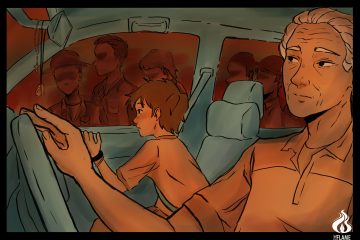By DENISSE P. TABOR

THE STANDARD for a good horror fiction lies in its ability to deviate from the reader’s expectations and heighten their wariness. Through an immersive yet unsettling atmosphere, readers are prompted to be on the lookout from start to finish because anything can go wrong at any time. However grotesque the characters look or how many the jumpscares are, the scare factor substantially relies on the storyline and the suspense it delivers.
That is exactly where the charms of Doki-Doki Literature Club (DDLC) lie. With its vibrant setting and delightful characters, it is hard to imagine the dark and sinister themes the story will descend into. Despite its start menu bursting with colors, the content warning is to be taken seriously as the game vividly displays graphics of self-harm and suicide which people might find uncomfortable — even triggering.
Created by Dan Salvato and his team, DDLC is a psychological horror visual novel in the guise of a dating simulation; paying homage to the genre of interactive media that swept Japan’s video game industry in the 1980s and remains to be well-liked to date. After its release in 2017, it was nominated for numerous awards, winning four People’s Choice awards at IGN’s Best of 2017.
Readers take on the mantle of a normal high school student living in an uneventful suburban neighborhood. They are first introduced to a character named Sayori, their childhood friend, who persistently nags the reader to join their school’s Literature Club.
There, the protagonist becomes smitten with three different girls, the personalities of whom resemble tropes and cliches: Monika, the typical popular girl whose looks gained the admiration of many; Natsuki, the tsundere who acts blunt and sarcastic towards the main character; and Yuri, the timid and self-conscious student who eventually opens up.
Like any typical dating sim, the reader follows different love routes; choosing between options that would appeal to their girl of choice. While trying to win her heart, sappy dialogues are exchanged with mellifluous music running in the background in adding to the romantic atmosphere. There is a lot of text to click through, and understandably so, for this familiarizes the protagonist with the varying degrees of chemistry they shares with each of the love interests.
At first, DDLC does not fall far from its chosen genre; it shares the hackneyed elements and straightforward plot of pursuing girls that are walking stereotypes. However, the game is not at all lighthearted. If anything, the budding romance between the potential love interests are clever misdirections meant to upend the reader’s expectations.
Expecting to woo three seemingly innocent girls only to be subjected to a web of deception is where the thrill of the game is found. Their multifaceted personalities that may win or lose the protagonist’s affection naturally unravels as the reader progresses into the story. All in all, managing to sit through the most boring part of the game is rewarding. It artfully builds anticipation only to shatter it in one go and leave the reader puzzled until the end, which is its goal all along.
Control is illusory. Unlike in other dating sims, the reader cannot end up with the character they tailor their choices to. Every choice they make has no bearing to the story’s indispensable parts despite suggesting otherwise — the story will still push forward to the direction it was programmed. They cannot circumvent the inevitable despite choosing the option that seems to evade them.
Doki-doki Literature Club shows the readers a world where everything is already predetermined. But more than that, it captures the inner battles a lot of people in the real world deal by using the lives of the three girls as vantage points. The only downside is their portrayal of the girls that comes off as patronizing.
With the girls’ excessive reliance on the protagonist and incapability of helping themselves, the reader emerges as a hero who does all the saving. It perpetuates the idea that the entirety of the girls’ existence are only meant to act for the pleasure and romantic interest of the protagonist.
This is where another message becomes apparent — it reminds the audience to refrain from being self-absorbed in order to impartially assess their roles in the lives of others. Sometimes, individuals can be so invested in the way others live that they tend to magnify their role and impact on it. What they fail to realize is that it was never about them to begin with. After all, one can never be a hero to others’ stories except for their own.
With its discussion of sensitive themes, DDLC tries to be as realistic as possible. The 2D animation contradicts the depth of its characters — underneath the bows and bubbliness are layers of inner battles and sad backstories. F



